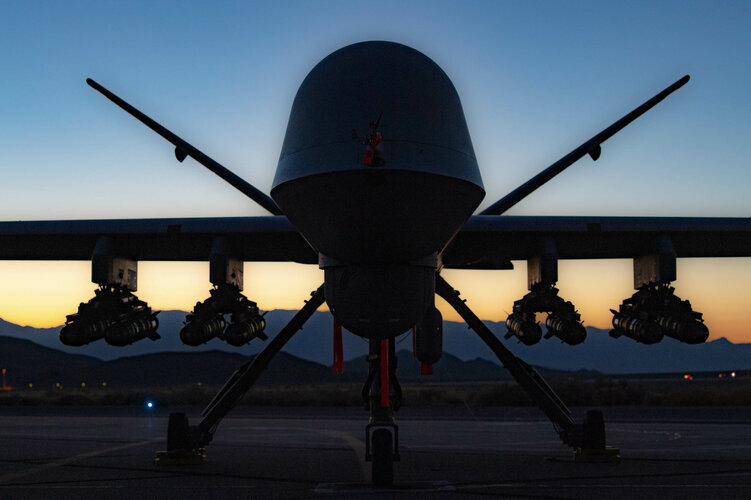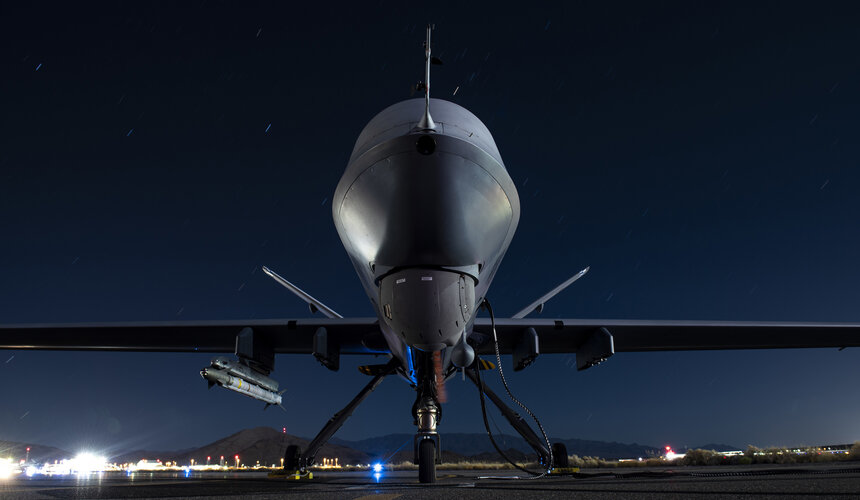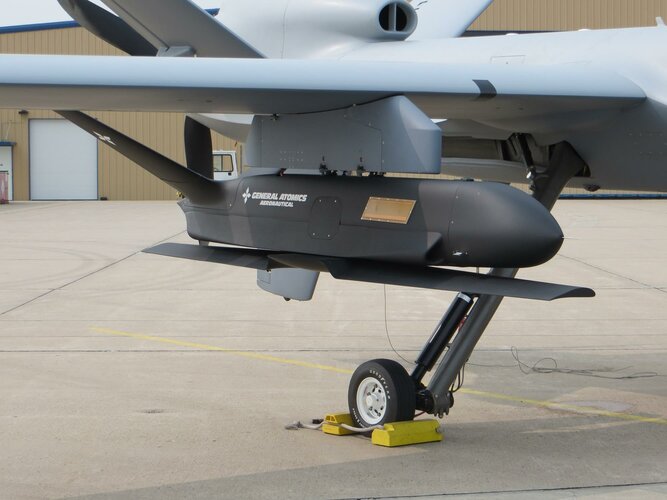GA is the truly newsmaker in this days!
General Atomics Aeronautical Systems has successfully completed flight testing of a newly developed Self-Protection Pod (SPP) on an MQ-9 Remotely Piloted Aircraft (RPA).
The project was executed as part of a Cooperative Research and Development Agreement (CRADA) with U.S. Special Operations Command (USSOCOM), and with the support of the Air National Guard (ANG), the U.S. Navy (USN), and industry partners Raytheon Intelligence & Space, BAE Systems, Leonardo, Leonardo DRS, and Terma North America. The demo was held Oct. 28, 2020 at the Yuma Proving Grounds (YPG).
During the testing, the MQ-9 was able to successfully track Radio Frequency (RF) and Infrared (IR) missile threats, deploy countermeasures, and provide real-time threat awareness and protection in a simulated contested environment.
The system is built upon an earlier joint demonstration of a podded AN/ALR-69A(V) Radar Warning Receiver (RWR) in 2017, which demonstrated the utility of an RWR to enhance aircrew situational awareness. In addition to the RI&S AN/ALR-69A(V), the pod features the Leonardo DRS AN/AAQ-45 Distributed Aperture Infrared Countermeasure (DAIRCM) System that utilizes a single sensor for both 2-color IR missile warning and wide field-of-view gimbal for threat countermeasures. The BAE Systems ALE-47 Countermeasures Dispenser System is used for dispensing airborne flares, chaff, and other airborne decoys. The RF countermeasure of choice demonstrated successfully during testing was Leonardo’s BriteCloud Expendable Active Decoy (EAD), which is a small, self-contained Digital Radio Frequency Memory (DRFM)-based expendable decoy.
At the heart of the Self-Protection Pod is the Terma AN/ALQ-213 Electronic Warfare Management System, which provides the interface, health, status, and command and control for the various systems installed in the pod.
During the testing, the MQ-9 was able to successfully track Radio Frequency (RF) and Infrared (IR) missile threats, deploy countermeasures, and provide real-time threat awareness and protection in a simulated contested environment.
www.ga.com
General Atomics Aeronautical Systems recently completed development and test of the world’s first self-contained Anti-Submarine Warfare (ASW) capability for an Unmanned Aircraft System (UAS).
On November 24, GA-ASI successfully demonstrated an ‘A’ size sonobuoy carriage, release, process and control from a company-owned MQ-9A Block 5 on a U.S. Navy Pacific test range. Using a SATCOM link, GA-ASI remotely processed bathythermal and acoustic data from deployed ‘A’ size Directional Frequency Analysis and Recording (DIFAR-AN/SSQ-53G), Directional Command Activated Sonobuoy System (DICASS-AN/SSQ-62F) and Bathythermograph (BT-AN/SSQ-36B) sonobuoys and accurately generated a target track in real time from the Laguna Flight Operations Facility located at Yuma Proving Grounds.
The MQ-9A Block 5 successfully deployed one BT, seven DIFAR, and two DICASS buoys to initiate prosecution and continuously track a MK-39 EMATT (Expendable Mobile ASW Training Target) over a three-hour period. Target track was generated using General Dynamics Mission Systems-Canada’s industry-leading UYS-505 Sonobuoy Processing Systems. GA-ASI is developing this first-of-its-kind capability for its new MQ-9B SeaGuardian UAS in partnership with the U.S. Navy under a Cooperative Research and Development Agreement with Naval Air Systems Command, Patuxent River, Md.
“This demonstration is a first for airborne ASW. The successful completion of this testing paves the way for future development of more Anti-Submarine Warfare capabilities from our MQ-9s,” said GA-ASI President David R. Alexander. “We look forward to continuing collaboration with the U.S. Navy as they explore innovative options for distributed maritime operations in the undersea domain.”
GA-ASI first demonstrated a sonobuoy remote processing capability in 2017 from an MQ-9A. Since then, GA-ASI has added a Sonobuoy Management & Control System (SMCS) to monitor and control deployed sonobuoys, and developed a pneumatic sonobuoy dispenser system (SDS) capable of safely carrying and deploying 10 U.S. Navy compliant ‘A’ size or 20 ‘G’ size sonobuoys per pod. The MQ-9B SeaGuardian has four wing stations available to carry up to four (4) SDS pods, allowing it to carry and dispense up to 40 ‘A’ size or 80 ‘G’ size sonobuoys, and remotely perform ASW anywhere in the world.
General Atomics Aeronautical Systems, Inc. (GA-ASI) recently completed development and test of the world’s first self-contained Anti-Submarine Warfare (ASW) capability for an Unmanned Aircraft System (UAS).
www.ga.com
General Atomics Aeronautical Systems completed the first Beyond Line of Sight (BLOS) High Frequency (HF) Command and Control (C2) demonstration for an Unmanned Aircraft System (UAS). The HF C2 capability does not require a Satellite Communications (SATCOM) link and is capable of providing BLOS connectivity up to 8,000 miles, depending on transmit power and link geometry.
For the demo, GA-ASI integrated the U.S. Government’s Collaborative Operations in Denied Environment (CODE) autonomy software into the Open Operational Flight Profile (OFP) of an MQ-9A Block 5 Remotely Piloted Aircraft (RPA) and flew the MQ-9 using improved diagonal tails with conformal HF antennas incorporated into the leading edges.
GA-ASI’s MQ-9 housed a FlexRadio Systems’ FLEX-6600 HF software-defined radio and associated hardware to translate and execute an autonomous mission plan. GA-ASI created a specialized HF software adapter to manage the unique latency and throughput constraints of the HF waveform to demonstrate BLOS command and control of the RPA.
The demonstration was flown out of Laguna Army Air Field/Yuma Proving Grounds on Dec. 16, 2020. The MQ-9 was commanded from Austin, Texas approximately 1,000 miles away over an HF C2 link.
GA-ASI completed the first Beyond Line of Sight (BLOS) High Frequency (HF) Command and Control (C2) demonstration for an Unmanned Aircraft System (UAS). The HF C2 capability does not require a Satellite Communications (SATCOM) link and is capable of providing BLOS connectivity up to 8,000 miles...
www.ga.com





















